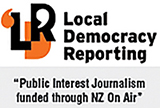Long road for Longbeach's lower speeds

“Finally.”
It’s been 14 years since Longbeach principal, Neil Simons, first approached the Ashburton District Council seeking a speed reduction outside his rural school.
The council has signed off on a 30kph variable speed zone around the school as part of its interim speed management plan, which is introducing 30kph speeds around all schools in the district.
“The safety of children is paramount,” Simons said.
“At peak times it is very busy, with 150 students trying to get out on to buses and into cars.”
All rural schools will soon have variable 30kph zones, operating at the start and end of the school day, while roads outside of all urban schools will become permanent 30kph zones – all day, every day.
Longbeach School is situated off the 100kph Longbeach Road and Simons has witnessed some “appalling behaviour” but generally drivers are aware of the surroundings and situation, he said.
“The tanker drivers have probably been the best at slowing down.”
There had been some council debate over it being 30kph for urban schools and 60kph for rural – “maybe because they believe rural kids run faster than town kids,” Simon said, but the council opted for a blanket 30kph.
Simons’ preference was 30kph and is happy to see it being adopted outside all schools to provide consistency.
The variable speeds will operate in a small timeframe in the morning and afternoon during the week when most motorists are already slowing down around rural schools anyway, he said.
“It would be more of an inconvenience hitting a child with a car,” Simons said.
With school buses parked on the roadside with hazard lights on he said it “makes the speed limit 20kph” passing them anyway.
Two rural schools, Lauriston and Dorie, will now have permanent 30kph zones because traffic data showed the speeds along the affected roads were close to 30kph anyway, roading manager Mark Chamberlain said.
One councillor believed the 30kph at rural schools is a step too far.
Councillor Lynette Lovett was concerned about impacting “the tanker drivers”, suggesting the variable speed outside rural schools should be lowered to 60kph, not 30kph.
“I think we have gone down too far on the country schools, from 100kph or 90kph right down to crawling speed for the transport industry,” Lovett said.
Roading manager Mark Chamberlain said the consistency of the 30kph was for maximum safety – whether a student was urban or rural didn’t matter.
Lovett’s concern about disrupting the transport network had her oppose the plan, with all the other councillors voting in favour.
Councillor Tony Todd called the extent of the speed zones “absurd” but still voted in favour of the plan.
Chamberlain said it can “all be reviewed at any time”.
The council will start implementing the new speed zones in early April and finish before the end of June.
- By Jonathan Leask

